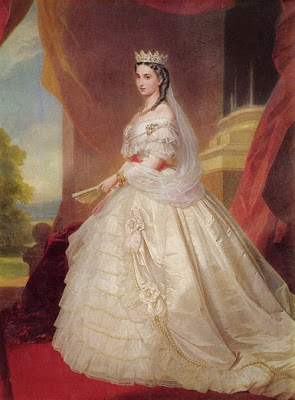Marie d'Orléans was the beautiful, accomplished and beloved younger sister of Queen Louise of the Belgians. Born at Palermo in 1813, she was the third child of Louis-Philippe, Duc d'Orléans, and his wife, Marie-Amélie of Naples, the future King and Queen of the French.The year after Marie's birth, her family returned to Paris, only to be forced to flee to England during the Hundred Days. In 1817, they finally returned to France, dividing their time between the Palais Royal in Paris and the country estate of Neuilly. Louis-Philippe and Marie-Amélie were known for their solid domestic virtues and Marie and her nine siblings were raised in a very affectionate and close-knit family. Marie was a lively, precocious, spontaneous, independent and mischievous girl.
Marie was very close to her eldest sister, Louise. Yet, they had markedly contrasting looks and temperaments. With her blonde curls, fair skin and blue eyes, Louise was a real "golden lily of France," so to speak, while Marie was a brunette elf. From her earliest years, 'la bonne Louise' was sober, steady, disciplined, docile, gentle, retiring; Marie was vivacious, ardent, charming, witty and outgoing, but also moody, whimsical, turbulent and undisciplined. According to Louise, she had a warm, good heart, but, despite her intelligence, a "bad head," and poor judgment. Nonetheless, throughout many political and personal vicissitudes, the girls found great comfort in each other's companionship. Marie seems to have been very dependent on Louise for her emotional tranquillity, and Louise looked after Marie with almost maternal care. The sisters' relationship always reminds me of that of Elinor and Marianne Dashwood in Jane Austen's novel, Sense and Sensibility.
Along with her siblings, Marie was carefully educated. Together, Louise and Marie took lessons in history, modern languages, literature, drawing, music and horseback riding. In politics, Marie was quite liberal, influenced, in this respect, by her father and her aunt, the formidable Madame Adelaide. In religion, Marie seems to have been initially less devout than Louise, but, with time and suffering, increasingly turned to God for consolation. From a young age, Marie had a special love for art. Her favorite painter was Van Dyck, but she also admired Titian, Veronese, Michelangelo, and, among the modern artists, Gericault. She was less attracted to the Flemish primitives, finding them soulless. Marie herself eventually became a noted Romantic artist, but not before many vicissitudes. Her early attempts at drawing frustrated her teacher, Ary Scheffer, who praised her rich imagination, but criticised the quality of her lines. Rather harshly, he remarked that he was tired of "correcting broken arms and twisted legs every day." Plunged, however, into deep depression by the departure of her sister, Louise, to marry Leopold I, King of the Belgians, Marie sought comfort by throwing herself wholeheartedly into art, particularly sculpture. At seven in the morning, she would begin working in her studio, with all the windows open, dressed austerely in a cotton skirt and blouse. Under Scheffer's supervision, she developed discipline and rigor, executing a number of fine works. She drew inspiration from historical topics, and one of her favorite themes was St. Joan of Arc.
The July Revolution of 1830, which brought Marie's parents to the throne, imposed new obligations upon the young Orléans, who, like their parents, now had to fulfill the public functions of royalty. Marie hated these official duties. The revolution also meant that Marie and her siblings encountered difficulties in finding spouses. Marie's grandfather, the notorious "Philippe Egalité," who had voted for the execution of his cousin, King Louis XVI, during the first French Revolution, had already branded the Orléans with infamy. Louis-Philippe's displacement of the senior Bourbons in 1830 reinforced the family's bad reputation. European royal houses were reluctant to form alliances with people viewed as renegades. Even those who might have been willing to overlook the unfortunate events of the past were put off by the Orléans's own insecure position. After delicate negotiations, and hopes alternately raised and dashed, the 24-year-old Marie finally married Duke Alexander of Wurttemberg, a nephew of King Leopold of Belgium. A year after the wedding, in 1838, Marie gave birth to a healthy baby boy, christened Philippe.
Sadly, however, the birth shattered Marie's own health. Like Louise, Marie had always been fragile, prone to colds, coughs and dizzy spells. Her depression at the deaths of her nephew, Louise's first-born son, Louis-Philippe, in 1834, and her governess, Madame de Malet, in 1835, had further weakened her. As an additional stroke of ill-luck, a disastrous fire, erupting in the middle of the night, had forced Marie, during her pregnancy, to flee outside, scantily clad, into the snow and ice. She fell victim to tuberculosis, and, despite her travels to warmer climes and her family's hopes and prayers, she passed away in January, 1839. By then deeply religious, she bore her agony with courage, contrition, resignation, even cheerfulness. She was only 25 years old. Despite her youth, however, she declared she was dying happily, thanks to her faith. "My friends, see the power of religion," she told her loved ones,"Nemours, see it for yourself, profit by it, and tell Chartres (1)."
(1)Her second eldest brother, the Duc de Nemours, who was present, was religious, but the Duc de Chartres, the eldest, who was absent, did not share his siblings' faith.
References:
Marie-Amélie, Queen, consort of Louis-Philippe, King of the French. Journal de Marie-Amélie, Reine des Français: 1800-1866, presented by Suzanne d'Huart, 1981.
Dyson, C.C. The life of Marie Amélie last queen of the French, 1782-1866. 1910.
Kerckvoorde, Mia. Louise d'Orléans, reine oubliée. 1991. See especially Chapter XVI, "Marie, Mademoiselle de Beaujolais."
Lassère, Madeleine. Louise reine des Belges: 1812-1850. 2006.






























